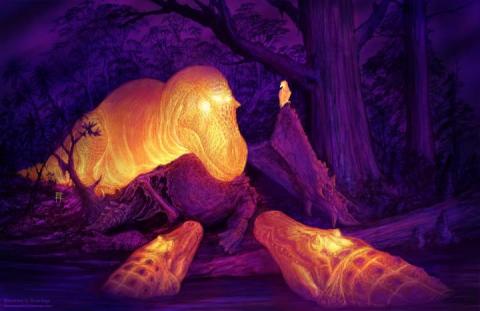But Casey Holliday, a professor of anatomy at University of Missouri-Columbia, didn't think that made much sense. "It's really weird for a muscle to come up from the jaw, make a 90-degree turn, and go along the roof of the skull. Yet, we now have a lot of compelling evidence for blood vessels in this area, based on our work with alligators and other reptiles."
For a new study, Holliday and colleagues used thermal imaging to examine alligators at the St. Augustine Alligator Farm Zoological Park in Florida and then examined fossilized remains of dinosaurs and crocodiles to see how this hole in the skull changed over time, and came up with a new hypothesis about the anatomy of a T. rex's head.

A graphic thermal image of a T. rex with its dorsotemporal fenestra glowing on the skull. Illustration courtesy of Brian Engh.
"An alligator's body heat depends on its environment," said Kent Vliet, coordinator of laboratories at the University of Florida's Department of Biology. "Therefore, we noticed when it was cooler and the alligators are trying to warm up, our thermal imaging showed big hot spots in these holes in the roof of their skull, indicating a rise in temperature. Yet, later in the day when it's warmer, the holes appear dark, like they were turned off to keep cool. This is consistent with prior evidence that alligators have a cross-current circulatory system -- or an internal thermostat, so to speak."
"We know that, similarly to the T. rex, alligators have holes on the roof of their skulls, and they are filled with blood vessels," said Larry Witmer, professor of anatomy at Ohio University's Heritage College of Osteopathic Medicine. "Yet, for over 100 years we've been putting muscles into a similar space with dinosaurs. By using some anatomy and physiology of current animals, we can show that we can overturn those early hypotheses about the anatomy of this part of the T. rex's skull."





Comments